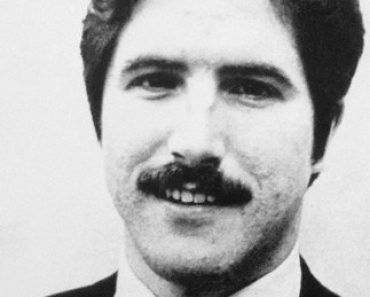Marc Sappington | Serial Killer

Marc Vincent Sappington
Born: 02-09-1978
Kansas City Vampire
American Serial Killer
Crime Spree: March 16-April 10, 2001
Incarcerated at El Dorado Correctional Facility, Kansas
No one paid much attention to Marc Sappington in March 2001 as he ambled along the side streets of Kansas City, Kansas. As he walked, Sappington weighed his options. “What about him?” he asked. “What about her?”
The questions were part of an attempt to quell the voices Marc Sappington was hearing in his head. These voices, auditory hallucinations, were commanding him to harvest human blood and flesh. And what if he didn’t comply? The voices had an answer. They would kill the 21-year-old churchgoer.
“He feared for his own safety,” said one cop who questioned Sappington.
Eventually, marc Sappington submitted to the imaginary demands. He killed four people, two of them in a single day. The murders were grisly. Sappington tried to suck the blood of two his victims, both of whom were also his friends. This effort in phlebotomy earned him the sobriquet, “Kansas City Vampire.” In another instance, he hacked a 16-year-old’s body into bite-size morsels that he consumed in his mother’s basement.
Marc Sappington Is Bright and Articulate
But what truly shocks about Marc Sappington is not the savagery of his crimes. It is his very ordinariness. Cops who have spoken to him say he is bright and articulate, even funny. Yet, the pathology is never too far away. In one interview with a Kansas City homicide detective, Sappington asked facetiously if he could chomp on the cop’s leg.
But Marc Sappington remains somewhat of a mystery to veteran investigators, defying almost every known profile of a serial killer or a cannibal.
Serial killers tend to be older, usually in their thirties; . It takes them a while to build up a pattern. Marc Sappington is young and so were his victims. Moreover, his alleged serial spree was unusually sudden.
Serial killers also tend to sexualize their crimes and never more so than when cannibalism is involved, law enforcement experts say. Jeffrey Dahmer is a case in point. He described his cannibalism as the ultimate act of sexual control. But Marc Sappington, the cops say, showed no sign of sexual deviance.
Serial Killers Are Most Commonly White Males
And, of course, serial killers – with the noted exception of the Atlanta child killer Wayne Williams a generation ago – are almost always white. Sappington is African-American, as were all of his alleged victims.
So how did this charming young man, with a quick smile and a quicker wit, become a conniving cannibal?
Who Is Marc Sappington
Marc Sappington grew up on the north side of Kansas City. A world punctuated by church bells and police sirens. It’s a place where Sunday morning preachers paint vivid word pictures of Hell and congregants don’t have to look very far to find it.
Abject poverty is as common as welfare. The African-American infants there, like their counterparts in the rest of the country, have a mortality rate twice that of white babies. While politicians thump their chests about declining crime rates, somehow the crime reductions never seem to happen in places like Kansas City’s north side.
But it’s also a neighborhood where thousands of decent people try to scrape by. A place where single mothers do what they can to keep their kids from falling into the traps of crime and violence.
Marc Sappington’s mother was one of them. A hard-working single mom who relied on her religion for solace, she had struggled to raise her son, Marc, alone. The boy’s father vanished before Marc was born. In fact, Marc Sappington never even met the man. That meant that his mother had to be particularly strong, and one of the ways she tried to instill a set of values in her son was to drag him to church every Sunday.
For the most part, her efforts appeared to succeed. Sappington developed into something of a choirboy, a rarity in a neighborhood where gangsta wannabes ruled the streets.
Marc Sappington Had A Quiet Charm
Although never a particularly good student, Sappington’s intelligence was revealed in a quiet charm. His engaging personality drew people to him, teachers, parents and other kids. Among the kids was Freddie, a skinny little 16-year-old whose real name was Alton Brown. Freddie genuinely admired Marc Sappington. He saw him as something of a big brother, authorities would later say.
By that point though, Sappington was hardly the perfect role model, despite his mother’s best efforts. As he reached adolescence, Marc acquired a taste for PCP, a drug which some say can make users paranoid, even psychotic.
Marc Sappington loved his “danks,” the street slang for cigarettes soaked in embalming fluid, dried and then smoked. Typically, his drug use resulted in a few minor and routine encounters with the police.
“There were never any crimes against people,” says Jerry Gorman, the assistant Wyandotte County prosecutor who is handling Sappington’s case.
At least not until March 16, 2001.
The Uncovering
They had been in the interrogation room for hours, but no matter what Lt. Vince Davenport and his two detectives asked, the reply was always silence. They tried to sweet-talk Marc Sappington, cajole him, frighten him, and nothing worked.
“There’s gotta be a way,” Davenport thought. Experience had taught him that there’s often one question using just the right words in just the right tone that can break down all resistance, and make a killer open up. This time, though, Davenport was having a hard time finding the right words.
Davenport knew better than to press his luck. Besides, it was getting late. As he fumbled to put on his coat, he promised himself that he’d do better the next day. He’d find the magic words.
Without looking up, marc Sappington began to speak. At first, Davenport wasn’t sure that Sappington had said anything at all. But the young man repeated the words.
Murder was one thing. But this was a different thing altogether.
“Vampirism. Cannibalism.”
The violence had begun a few months earlier. While trolling the streets of his north Kansas City neighborhood, Marc Sappington struck up a casual friendship with a young man named Armando Gaitan.
The younger Gaitan was the exemplar of everything that Sappington’s mother had tried to prevent. Gaitan, was a gangsta wannabe, the cops say, a budding young tough guy who believed that he could, and should, live by the code of the street.
Then, in early March, Gaitan and Sappington got their hands on an assault rifle. It was a beautiful gun, the kind of weapon that lends status to a young street tough. But the only way to make themselves, and the rifle, truly important was to use it.
So they hatched a plot to pull off an armed robbery. They didn’t have any particular target in mind, Lt. Davenport said later. They were just searching for a random target. The one they found was David Marshak.
What Gaitan had in mind was straightforward.. They’d walk up to Marshak, show him the gun, demand cash and jewelry, and that would be the end of it. Gaitan would do the talking. All Marc Sappington had to do was brandish the rifle’s polished steel.
Marc Sappington Murders In Cold Blood
Like most people in these circumstances, Marshak did not resist. But Marshak’s cooperation did nothing to help him. For reasons that not even Sappington can provide, authorities say, Sappington opened fire and killed Marshak. Suddenly, Marc Sappington had entered the world of homicide.
After the murder, Gaitan fled to Texas, while Sappington stayed in Kansas City. Although Gaitan was arrested a short time later, he refused to tell police the shooter’s identity.
Shame and Fear
Back in the Kansas City interrogation room, Sappington had begun to talk – and talk and talk. He offered a detailed and emotional recounting of his crimes. He spoke of how he had drank blood and eaten flesh.
As Marc Sappington’s story unfolded, another question arose. What had prevented Sappington from talking in the first place? The answer, his inquisitor, Lt. Davenport believed, stemmed from his religious upbringing.
Simply put, “It was shame,” Davenport said.
Curiously though, Sappington’s god-fearing instruction had no effect on the nature of the voices he heard or how he responded to them. Typically, those suffering from the sorts of delusions Marc Sappington endured attach to them some supernatural significance. They are commands from God or Satan, or both.
Yet Sappington never offered a rationalization, aside from fear of punishment the voices vowed were in store if he didn’t act on their commands, as to why he followed their instructions. If anything, it is that logical gap in Sappington’s madness which makes his case so unusual.
As controlling as the voices were, telling Marc Sappington when to kill and what to do afterwards, they never selected the victims. That was left to Sappington. And Sappington’s methodology was chance.
Marc Sappington Talks To The Voices In His Head
“The really scary thing is that the victims could have been anybody,” Davenport said. “He talked to me about going out on the street and looking at people, asking the voices in his head ‘What about him? What about her?’ These people never knew that it could have been them or that they could have been killed and eaten.”
On the Hunt
Marc Sappington searched for three weeks before finding his first victim. Despite Sappington’s perambulations in search of a stranger, the person he alighted upon was a neighborhood friend.
Terry T. Green, 25, was a longtime friend of Sappington’s. They would often spend time at each other’s homes. So there was nothing atypical when Green showed up unannounced at Sappington’s door on April 7, 2001. It was, Davenport later said, just an extreme case of “being in the wrong place at the wrong time.”
Soon, according to Sappington, the voices took over. They told him to lure Green to the basement of his mother’s home. They also told Sappington to attack Green with a hunting knife that he had hidden in one of the basement’s corners.
The slaying happened with such fury and ferocity that the walls of the basement were splattered with blood, crime scene investigators noted. With Green lifeless on the floor, the voices allegedly told Marc Sappington that they had one more command for him.
Obeying the voices, Sappington later said, he knelt down over the body of his friend, and began to lap up his blood. But Sappington left the task unfinished. He heard a noise and the voices told Sappington to dispose of the body immediately.
Marc Sappington Disposes Of The Body
Sappington could not have picked a more obvious place to dump Green’s remains. Using his mother’s car, Marc crossed the river and entered Kansas City, Missouri. Sappington then drove to the edge of a parking lot at a nightclub he and Green frequented. He dumped the covered body into a car’s backseat.
Of course it didn’t take long for the Missouri police to find the body. The Missouri police saw the homicide as a Missouri crime. Although Kansas City, Kansas, authorities heard about the discovery, they were simply relieved that they did not have another murder on their hands.
“We heard about it,” said Gorman, the Kansas prosecutor. “But we figured it was their murder and we have enough murders of our own.”
It took police three days to link Sappington to Green’s murder. But now that his killing spree was finally underway, Marc Sappington managed to kill two more people before his capture.
Serial Killer
Twenty-two year-old Michael Weaver — another friend of Sappington’s — was next.
It was April 10, just three days after Green’s death. The voices told Marc Sappington to go hunting again, and despite the arduous selection process he used for the second time, Sappington wound up with a victim much like Green.
Sappington spotted Weaver sitting on the steps of his house. The pair struck up a conversation with Sappington suggesting they go for a drive in Weaver’s car. In a shadowy alley only three blocks from Sappington’s home, he fatally stabbed Weaver.
Then Marc Sappington went through the Terry Green routine. The voices told him to drink Weaver’s blood, but he soon abandoned the task out of fear of discovery. Sappington fled, leaving the body behind.
Marc Sappington had killed three people, Marshak, Green and Weaver. With a trio of homicides behind him, Sappington was officially now a serial killer.
That murder tally did not last long, however. On his way home from the Weaver murder, Sappington spotted “Freddie,” the teenager who adored Sappington. The voices liked the new target, and Marc Sappington invited Freddie back to his house.
Enter Cannibalism
This time Sappington used a shotgun to kill. Finally, Sappington was free of distractions and could quaff blood. But there was one more ingredient.
Sappington crudely butchered Freddie’s body and then proceeded to feast upon raw flesh. His repast complete, he stuffed what was left of Freddie into a trash bag, leaving his leftovers on the basement floor. Then Sappington left the house, beginning what could be considered a postprandial stroll.
The Endgame
Sappington’s mother discovered the crimson-drenched scene a few hours later. Although she rarely ventured down to the basement, which was considered her son’s territory, she could hardly ignore a trail of blood drops near and along the cellar stairs.
After she had a panoramic view, Sappington’s mom called police.
It didn’t take long for the cops to find Marc Sappington on the street. But Sappington decided to flee, commandeering a passing car. He forced the female driver into the passenger seat and led police on a brief chase.
Back at the youth detention center, Armando Gaitan, the co-conspirator in the robbery that led to Sappington’s first murder, was still refusing to name his accomplice. Based on a sketchy description from a witness to the hold-up, police began to suspect that Marc Sappington was the killer.
So Gaitan’s interrogators deployed perhaps the most effective tool in police work: the truth. They told Gaitan about Sappington’s other horrific murders. Realizing that he was no longer protecting another neighborhood street thug, but rather, a homicidal psychopath, Gaitan named Marc Sappington.
The People vs Marc Sappington
It’s been nearly a year since Sappington’s arrest, and he has remained in custody in the Wyandotte County Jail on $2 million bail.
He has undergone a battery of psychological and psychiatric tests. Although some prosecutors say privately that they doubt Sappington’s story about the “voices,” even the most cynical observer must conclude that this defendant suffers from severe mental illness. As a result, prosecutors have chosen not to seek the death penalty.
Marc Sappington is currently serving four consecutive life sentences.

source: murderpedia / as told by Seamus McGraw
This site contains affiliate links. We may, at no cost to you, receive a commission for purchases made through these links












































